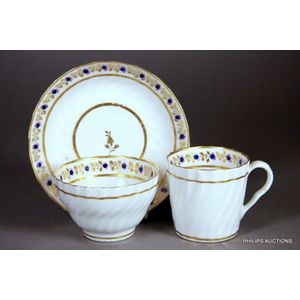Qianlong Armorials Trio with Blue and White Decoration
You must be a subscriber, and be logged in to view price and dealer details.
Subscribe Now to view actual auction price for this item
When you subscribe, you have the option of setting the currency in which to display prices to $Au, $US, $NZ or Stg.
- Armorial / Armourial - Bearing a coat of arms. Coats of arms came into general use by feudal lords and knights in in the 12th century, and by the 13th century, arms had spread beyond their initial battlefield use to become a flag or emblem for families in the higher social classes of Europe. They were inherited from one generation to the next. When a family crest is used on individual items of silver or furniture it is an indicator of the aristocratic standing of the family represented.
Armorials were also used to decorate mass produced ceramic souvenir ware by such companies as Goss, Carlton & Shelley, and in these cases the coats of arms displayed were of boroughs and cities. - Gilding - Gilding is a method of ornamentation whereby a thin sheet of gold metal is applied to items made of wood, leather, ceramics, glass and silver for decorative purposes.
For furniture including mirrors, the sheet of gold is usually applied over a coating of gesso. Gesso is a mixture of plaster of Paris and gypsum mixed with water and then applied to the carved wooden frames of mirrors and picture frames as a base for applying the gold leaf. After numerous coats of gesso have been applied, allowed to dry and then sanded a coat of "bole", a usually red coloured mixture of clay and glue is brushed on and allowed to dry, after which the gold leaf is applied. Over time parts of the gilding will rub off so the base colour can be seen. In water gilding, this was generally a blue colour, while in oil gilding, the under layer was often yellow. In Victorian times, gilders frequently used red as a pigment beneath the gold leaf.
Metal was often gilded by a process known as fire gilding. Gold mixed with mercury was applied and heated, causing the mercury to evaporate, the long-term effect of which was to kill or disable the craftsman or woman from mercury poisoning. The pursuit of beauty has claimed many victims, not the least of which were the artists who made those pieces so highly sought after today.
This item has been included into following indexes:
- Chinese ceramics, decoration - blue and white, other 760
- Chinese ceramics, dynasty mark or period - various items, Qianlong mark (1736-1795) 481
- Chinese ceramics, export ware - export ware, other 222
-
Chinese ceramics, item type
- cups, cups & saucers 302
- mugs and beakers 95
- saucers 261
- tea bowls 243
Visually similar items

A Chamberlain's Worcester trio, circa 1795-1,800, of shanked or fluted decor the saucer, tea bowl and coffee can with blue and puce floral borders with gilt enrichments between gold borders, unmarked, Heights: 5.5 cm, and 6.5 cm, diameter 14 cm

A Samson of Paris cup and saucer, circa 1890, marked underside with a 'Curvaceous X' to indicate English-style Ware, both straight sided cup and saucer with grisaille decoration of a European lakeside landscape with figures, boats and castles upon a lemon

Antique early 19th century cup and saucer (probably Coalport)

A small French silver tastevin embossed with bunches of grapes, double snake handle and border with lettering 'Protege La France', 19th century, 7.8 cm wide, 29 grams
